The SLOUGHI
100 years running
Reproduced with permission from "The Performance Sighthound Journal" in which this article was first published.
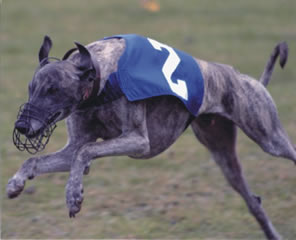
BISS IABCA International & Veteran Ch. Fahel Shi'Rayân,
FCC, SORC, SGRC5 © Standerford 2003
“In the keenness of the chase, it is transformed:
the pure and generous blood that flows in its veins galvanizes
it; its disdain and nonchalance disappear; it becomes all
fire, all flame, with a courage and endurance that are only
equaled by the speed of its race to seize and put to death
the game on which it was set.”
H .Seville, about the Sloughi, in La Vie a la Campagne, January
15 1911(translation Susan Bamford)
Although well known if not very common in Europe since the
1800s, the Sloughi is a relatively “new” and rare
breed in America. When being asked about the breed, here are
answers to some of the questions Sloughi owners are often
asked.
What is a Sloughi, and where does it comes from?
The geographical origin of the Sloughi breed is the North
African countries of Morocco, Algeria, Tunisia, and Libya.
The Sloughi is originally the lop-eared smooth Sighthound
of the Berber people, and later on also of the Arab. The breed
is often thought to belong to the group of lop-eared oriental
Sighthounds, and there has been considerable speculation about
the relationship of the Sloughi with the Saluki – the
Sloughi being seen as a smooth Saluki- in the English speaking
countries. However, recent mitochondrial DNA studies by Dr.
Savolainen in Sweden, show that the Sloughi has an ancient
origin imbedded in North Africa, with little relationship
to other middle eastern Sighthounds such as the Saluki, the
Afghan hound and the Tazi. How the breed exactly evolved over
centuries in North Africa, to become what it is today is lost
in time and at best a matter of speculation. The Berber people
have inhabited North Africa since the dawn of time, and their
countries were invaded over the centuries by various people
from other cultures, including the Romans, the Vandals, and
the Arabs, who brought their dogs with them. How the invaders’
dogs interacted with the local hunting dogs and vice-versa
is unknown. Lop-eared Sighthounds were also depicted in Ancient
Egypt artifacts thousands of years ago. They were often offered
as part of tributes to the Pharaohs by Nubia, South of Egypt,
and are thought to be the ancestors of today’s lop-eared
Sighthounds. However, how the Sloughi relates to the smooth
lop-eared Sighthound of Ancient Egypt remains unresolved in
the absence of any genetic study of these ancient hunters.
How does a Sloughi look like?
The Sloughi is a medium-sized lop-eared Sighthound. Its coat
is always smooth. The colors are in all nuances of pale sand
(cream) to red (red fawn, mahogany), with or without black
mask, black ears, brindling, black mantel and dark overlay.
Coats with invasive white patches, and dilutes (blue) are
not accepted in the breed. A white patch on the chest and
a few white hairs at the tip of the toes are tolerated in
otherwise outstanding specimen of the breed, and in darker
coats – such patches being easily overlooked in light
colored coats. Square in proportions (from wither to hips,
to hind feet to front feet), the Sloughi is both lean and
strong. Bitches are typically smaller and more refined than
their male counterparts. In general, the Sloughi gives the
impression of being more lightly built than the Greyhound,
and the male Sloughis look sturdier than Salukis. The typical
expression of the breed is somewhat sad and melancholy, the
eyes, dark brown to amber, are lined in black as if with eyeliner.
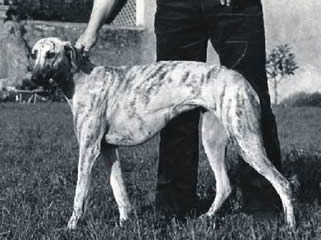
Uddah, first Sloughi racing in Switzerland, the typical looks
of the breed © de Caprona 1972
What is the role played by the Sloughi in North Africa
In the old days the Sloughi hunted gazelle, desert hare, antelope,
fennec (desert fox), hyena and ostrich, sometimes boar, and
jackals. Today the breed is used to hunt gazelle, desert hare
and fennec; its main role in some areas being to control the
jackal populations which attack goat or sheep herds and poultry.
In Tunisia, the traditional hunt represents a Berber rider
galloping behind his Sloughi chasing prey. In Morocco, Sloughis
on a coupler accompany riders for jackal hunting.
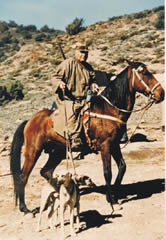
Moroccan Caid with 2 Sloughis on a coupler, © Schritt
The Sloughi is also a reliable guard dog, with a keen sense
of its own turf, who they know and do not know, who is welcome
and not welcome -in other words, an all around working dog
that has survived the tough conditions in North Africa.
The Général Daumas writes in 1850 that the Sloughi
is the only dog treated as family and allowed into the tent.
A Bedouin would go without his own blanket to provide his
Sloughi with warmth in the cold desert nights and puppies
were often breast-fed by Bedouin women to help nursing bitches.
At the end of his owner's life the Sloughi is, like the horse,
part of the precious inheritance his owner leaves behind.
At the end of his life the Sloughi is mourned like family.
Of course a great part of the admiration the Berbers and Arabs
have for their Sloughis relies heavily on the dogs’
prowess in hunting, because they brought food to the family,
and many traditions surround hunting with Sloughis and the
training of the young Sloughi for hunting.
Because it is thought so very valuable, several traditions
evolved to protect the Sloughi .In General Daumas’ own
words "Pleasure is taken in adorning him, in putting
shell collars on him. He is protected against the evil eye
by the talismans put on him". The feet of the Sloughi
are also dipped in Henna to bring good luck.
Both in Algeria and Tunisia, the ears of the Sloughi are cropped
up allegedly to prevent them from being torn to pieces when
hunting jackals - a cornered jackal throws himself on the
back and defends himself thrashing with his front paws. The
front legs are also brand- marked when the Sloughi is 6 months
old, by using a heated " cerpette" applied in a
slanted position on the inside of the front leg. Not only
are such brand-markings specific for each tribe, they are
also thought to keep the legs straight, preventing malformation
of the joints, thus improving running. The few pictures of
Libyan Sloughis show that they do not have cropped-up ears,
nor any marks on their front legs. This tradition does not
seem to be widespread in Morocco either.
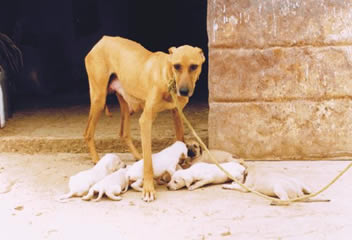
Tunisian Sloughia with cropped up ears and her pups ©
de Caprona 1999
An organized Sloughi breeding of the highest sophistication
existed in Morocco in the 1920s-1930s. In this country, the
secret of breeding Sloughis was transmitted from father to
son. Such families have had Sloughis for many generations.
El Glaoui, the Pacha of Marrakesch, and many princesses also
contributed to the high quality of the Moroccan Sloughis.
Sadly, political upheavals brought an end to all of this.
According to Durel (Algeria,1942) the Arab and the Berber
take the breeding of their Sloughis very seriously. The owner
of a great dam will ride on horse or camel miles across the
desert to take her to a sire well known for his beauty and
hunting ability. The selection of breeding Sloughis is severe
and it preserved intact this fascinating breed .
A sentence to Armin Schmid by an old Patriarche at the Casablanca
1989 Dog show : "Quand on rêve d'un Sloughi, on
rêve d'un ami" or "When you dream of a Sloughi,
you dream of a friend" shows this special relationship
of the Berber to his Sloughi. The very good Sloughi is never
sold but given as a precious gift to the best friends .
What were the beginnings of the Sloughi breed in the
Western World?
France and Holland were first to import this breed in the
late 1800s. In fact the Sloughi was imported and well known
there at a time when the Saluki and the Afghan hound were
not yet well identified. The Sloughi was already admired as
a driven hunting Sighthound breed and old engravings can be
found in hunting books of the time. Litters were born, bred
in the Netherlands by the artist Auguste le Gras in Holland
(kennel Beit es Sleq) and Michel La Fontijn (kennel Sahara),
in France by the artist Mrs Simeon-Lavallart (kennel du Simoun),
and in Germany by Mrs Ellen Windecker-Castan (kennel von der
Burg Windeck). In the Netherlands a Dutch “Sloeqi club”
was created in 1903 and the first brief Sloughi standard written
by Auguste LeGras, and Sloughis were racing as early as 1926
– there was no coursing then.
Sloughis in those days were also brought back by French cavalry
officers who had been stationed in North Africa and who had
discovered the hunting prowess of the Sloughi there - and
soon the breed was described as one of the best coursing hounds
in French canine literature. A “Club Français
du Sloughi” was founded in 1928 to sponsor the breed,
shortly after the first standard for the breed was put together
in 1925 by the French Sighthound Club (Club Français
des Lévriers), and recognized by the Society for the
Betterment of Dog Breeds in France ( Société
Centrale pour l'Amélioration des Races de Chiens en
France). From then on the Sloughi was a French Sighthound
breed, until Morocco took over as the country representing
the breed in the 1970s.
Some enthusiastic reports show us how much the breed had impressed
its Fancy. H. Seville in January 15 of 1911, in the Journal
Country Life (La Vie a la Campagne) describes the Sloughi
as a proud, disdainful and laid back breed that turns into
an incredibly fast, courageous and resilient hunter once it
is set loose on game. He predicts that, should Coursing and
Racing in France become well established, the Sloughi would
no doubt shine up front.
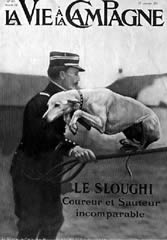
" The Sloughi Incomparable Runner and Jumper” La
Vie a la Campagne 1911
A few years later, O. Malescot, secretary general of the Club
Français du Sloughi tells in 1929 of his experience
with running his untrained Sloughis for the first time. In
his own words:
"One Sloughi, followed closely by the others, completed
the 500m circuit in 31” (58.064 km per hour) while the
top Greyhound bitch, imported from England, extensively trained
on the lure, did the circuit in 29” (62.069 km per hour).”
He goes on describing the astonishment of the Greyhound trainers
exposed for the first time to the Sloughi’s intensity
and drive in racing in the absence of prior training.
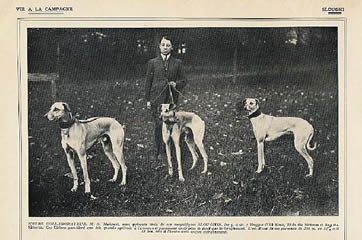
Mr.O.Malescot and his Sloughis, La Vie a la Campagne1929
However, as with many other things, all these endeavors came
to an end with World War 2. Breeding stopped or was destroyed,
such as the tragic end of Mrs Ellen Windecker-Castan’s
kennel von der Burg Windeck in Germany, as she witnessed the
Russians gunning down all her Salukis, Afghans and Sloughis.
What happened to the Sloughi breed after World War II?
Limited breeding resumed in France during the 1950s with two
kennels working together: the “des Barines” kennel
of Mrs. Patricia Sigaux and the “d’Ymauville”
kennel of Mrs. Françoise Stacul. Miraculously, some
the bloodlines of the d’Ymauville kennel survived through
the Kahloul de la Treille breeding of Mrs. E. Rohde-Goudineau
in France, and are some of the roots of some of the top racers
and coursers in the USA today. The foundation dogs of the
d’Ymauville kennel came from Algeria, Tunisia and Morocco.
Some were bred by Xavier Przezdziecki, who was then breeding
Sloughis in Algeria and organized Sloughi racing in Algiers
at the time. Lt. Colonel Gaston also bred Sloughis in the
1960s, but, it wasn’t before the 1970s that the renaissance
of the Sloughi breed took place in Europe. This was the time
when the French returned with their Sloughis to France, after
the end of the war in Algeria. Breeding in France, Germany
and Holland took on new proportions then, and many of the
bloodlines show the international cooperation between the
breeders of the time.
The Sloughi was recognized for racing in Germany in 1973.
The first race took place in Hessen, Germany, with an entry
of 5 Sloughis won by Arabeya Schuru-esch-Schams. In 1974 the
Sloughi became an official breed in international racing.
The first American bred Sloughi to win Coursing and Racing
events in Germany was Ghada Shi'Rayân, daughter of A’Ssissa
Shi’Rayan (pioneer of the breed in the USA) and owned
by Brigitte Noack.
In 1980 in France Malik, Mandane, Ô Kaline, Naiade,
Jenna and Nitouche du Montouchet de la Horde d'Or were the
first 6 Sloughis which were recognized for racing. At the
end of 1980, they received their "working booklets",
then in 1981, those of the "Union Internationale de Courses
de Lévriers" and in 1984 the booklets of the "Fédération
des Sociétés de Courses de Lévriers".
These dogs ran distances of up to 900 meters.
In Holland, the Dutch Club for Oriental Sighthounds, (NVOW,
Nederlandse Vereniging voor Oosterse Windhonden) which replaced
the Sloeqi Club, designed in 1989 a dual champion title which
combined conformation and performance results. The first dog
and bitch to win this title were Beldi (3 times 1989-1990-1992)
and Barud Kamar al Akbar (5 times,1989-1993), owned by Els
Siebel. In 2004 for the first time a Sloughi is the all breeds
winner of the 3 day triathlon event organized by the Coursing
Club Nienoord Leek (May 22-23). Her name is Bashira Sheik
el Arab owned by H.& A. Duncan, bred by Patricia Lauer
in Germany- the first successful AI litter in Germany with
frozen semen of North African import to the USA Tarfa with
the German bitch Aljana Sheik el Arab
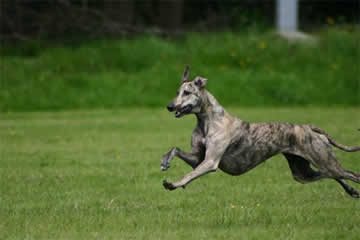
Bashira Sheik el Arab, the Netherlands, running the triathlon
© Els Siebel 2004
In Switzerland probably the first Sloughi to have completed
a racing license was Uddah in 1972 (owned and bred by the
author) on the racing track of Versoix. From the records available,
she was followed by other dogs in 1979-1980. Uddah also participated
at the International Race in Geneva (on the track of Versoix)
in 1973, and thus must have been the first Sloughi to do so
in Switzerland. Sloughis participated later again at a National
race, the Züri-Meisterschaft, Rifferswil, on Mai 18 1980.
The next international race, the Eurocup, on Mai 22 1980,
was also on the track of Rifferswil
In Finland American-bred Jaraa Shi'Rayân owned by Tarja
Matikainen became the first Coursing Champion and Syringa
Harmony owned by Anna-Marie Roenkkoe the first Derby winner
in 2001. In Sweden, Syringa Headline owned by R.Wilson, became
the first Swedish and Norwegian Coursing Champion. Headline
and Harmony are littermates of Syringa Happiness at Shi'Rayân
in America.
What is the story of the Sloughi in the American racing
and coursing venues?
In the United States of America, the Sloughi Fanciers Association
of America (SFAA) was founded in January 1 1988,. SFAA is
the premier and oldest American Sloughi Club and has the oldest
Stud book. Six years later after it was created, its members
succeeded in getting the breed recognized by the National
Oval Track Racing Association (NOTRA, 1994), after a demonstration
run in Colorado in August 1994 with the Rocky Mountain Sporting
Whippets Club, and with its president’s Jack William
Lewis enthusiastic support .In 1995 the Sloughi became a foundation
breed of the Large Gazehound Racing Association (LGRA), created
by Jack William Lewis (Rheata Whippets), to satisfy the request
of Sloughi owners to enable their breed to compete in sprint
racing.

Jack William Lewis and the first 2 SGRCs for the breed
Ch. A’Ssissa and Ch. Aswad Shi'Rayân © de
Caprona
In 1996, the American Sighthound Field Association (ASFA,
lure coursing) created the miscellaneous stake for rare breeds
of Sighthounds which include the Sloughi, and recognizes the
breed in 2001.
In 2004, SFAA provided the American Kennel club with a folder
documenting the coursing and racing talent of the Sloughi,
and the AKC enabled the breed to participate in AKC Coursing
events.
What is the running style of a Sloughi?
Although capable of tremendous starting power in sprint, the
Sloughi is typically a long distance runner. Because of its
square proportions, it cannot flex its back as much as the
Greyhound, but can take much sharper turns. The general style
of a Sloughi racing is that of a tight and smooth runner with
tremendous leaping power.
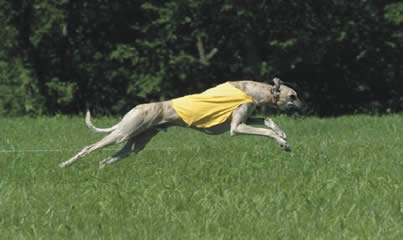
FCI International, Puerto Rican, Latin American Ch. Mathal
Shi'Rayân,
Leaping forward, Shot on Site 2004
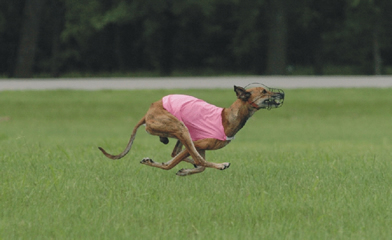
IABCA International Ch. I’Saar Shi'Rayân, ORC,
SGRC. Double suspension gallop © Shot On Site 2004
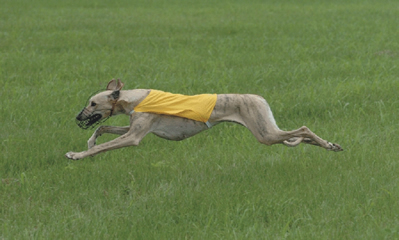
Munya Shi'Rayân, GRC, extended phase of the gallop,
Shot on Site 2004
In lure coursing, Sloughis typically work the lure together,
changing places as the lure turns, hunting the lure more than
simply chasing it. Sloughis always keep track of their bearings
as they run: they often turn their heads to check where the
other Sloughis racing are and sometimes to see where the owner
is, or check the judges. This is not to be confused with interference,
as such behavior is not accompanied by other behaviors hampering
or interrupting the course of another Sloughi.
This turning of the head is also seen in young Sloughis during
their first oval or straight races, and should not be confused
with a DQ. A Sloughi simply checks things out all the time,
and turning the head to see what is going on around him is
an intelligent way on keeping track of things.
At all times the Sloughi is aware of everything happening
in its field of vision, and although a coursing Sloughi can
be very focused on the lure, it can be distracted by another
piece of plastic floating in the wind, a horse riding near
the field, a commotion of dogs barking, or other fun furry
things to chase. Sometimes, in courses which comprise a loop
within a loop, some individuals will stop as the first loop
comes close to the starting point, probably thinking this
is the end of the course as they come close to their owner
-and everything else which identifies the start and end of
a course, namely people and lure-coursing equipment - not
realizing that the course is not yet completed. Sloughi owners
(which includes the author) are sometimes the comic relief
when they flatten on the ground or hide behind trees when
their dogs are coursing, hoping their dogs will not spot them
on the field.
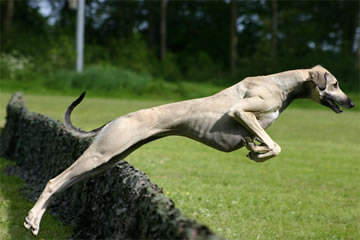
Ferda Kamar al Akbar, steeple chase, the Netherlands ©
Els Siebel 2004
The leaping skills of Sloughis are documented in steeple
chase coursing events in Europe. In the USA, sometimes the
oval, straight or coursing tracks will provide for such opportunities.
There is nothing more impressive than a heat of Sloughis leaping
in unison over a big puddle of water in their way, and resuming
the race without missing a beat.
In general the breed is not prone to injuries, provided the
dogs have been properly conditioned for the sport.
What are the bloodlines behind the top racing and coursing
Sloughis in the USA?
Aswad Shi'Rayân, Amir Shi’Rayan and A’ssissa
Shi’Rayan, pioneer Sloughis in American coursing and
racing, were littermates of a litter of 4 puppies, the first
litter born at Shi'Rayân, April 5 1993. They were the
result of an outcross between a German dog bred by Mr. Wandel,
Damir el Tahiri, whose pedigree revealed top performance German
Sloughis of Schuru-esch-Schams (bred by I. & E. Schritt)
and French Fehda Fayrouz Kahloul de la Treille (bed by E.
Rhode-Goudineau). Aswad and A’ssissa are behind most
of the top racers and coursers to date (2004) in America and
in some Scandinavian lines as well. Sloughis imported from
Europe and countries of origin in North Africa to the USA
also contributed to the American and European coursing and
racing Sloughi bloodlines. Names that come to mind are German
Chamisa Schuru-esch-Schams, Tunisian Tarfa, Algerian Ramla,
Swedish Syringa Happiness at Shi'Rayân, French Farissa
Fediha Kahloul de la Treille.
Which canine organizations recognize the Sloughi breed?
The Sloughi is an official breed of the Federation Cynologique
Internationale (FCI) since 1935, the International All Breeds
Canine Association (IABCA), the United Kennel Club (UKC),
and various rare breed registries in the USA. In 2004 the
American Kennel Club welcomes the breed in Agility, Tracking,
Obedience and Lure Coursing events. The Sloughi is also represented
in the British Kennel Club with, still, limited privileges.
How many Sloughis are there?
There are some 4000 Sloughis registered worldwide, starting
in the early 1900s. There are some 900 Sloughis registered
in Holland, combining the pre- and the post- World War 2 Studbooks.
Germany is the country with the largest registry for Sloughis
with over 1200 dogs, most of them bred since the 1970s. There
are roughly 300 Sloughis currently registered with the Foundation
Stock Service of the American Kennel Club in the USA.
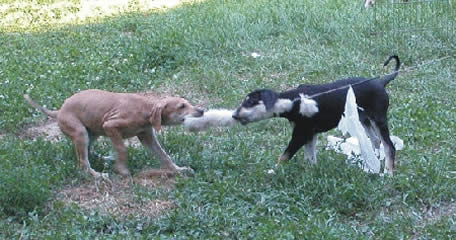
The next generation, 7 weeks old Shi'Rayân puppies,
playing with the lure © de Caprona 2004
| Some Sloughi facts The Sloughi
and lure-coursing (ASFA)
Most of the activity with Sloughis in lure-coursing
took place in the Midwest.
On April 16, 1995 in Omaha, the first Sloughis were
certified for lure coursing, under judge Elaine McMichael.
They are Ch. Aswad Shi'Rayân, Amir Shi'Rayân,
Ch. A'ssissa Shi'Rayân, Ch. Chamisa Schuru-esch-Schams
and Rif de Moreau, owned by the author
In 1996, others followed: Ch. Dounia Shi'Rayân:
April 13 (NCA, under Frank Zaworski)
Ch. Bouthayna Shi'Rayân: April 14(NCA under Susan
Weinkein), Ch. Balsam Shi'Rayân and Ch. Badir
Shi'Rayân: August 17, (NCA under Frank Zaworski),Ch.
Bassel Shi'Rayân and Ch. Dalal Shi'Rayân:
October 5, (ICA under Sue Kirkham)
The first ASFA trial in which Sloughis were entered
was organized by the Nebraska Coursing Association in
April 1996 and won by Aswad Shi’Rayan.
On September 1, the first Sloughi fulfills the requirement
for a Field Champion by winning first in an entry of
7 Sloughis: Ch. A'ssissa Shi'Rayân, Minnesota
Coursing Association, under judges Marie Adams and Mary
Ann Armbuster-Smith
Thus by the end of 1996, 11 Sloughis are certified for
lure-coursing and the first Field Champion title for
the breed is finished (later named Foundation Coursing
Champion title). It is followed shortly thereafter by
the first male Foundation Coursing Champion Aswad Shi'Rayân,
and the only Foundation Courser of Merit to date in
ASFA was Bouthayna Shi'Rayân. Bouthayna is also
the highest pointed Sloughi in ASFA today. There are
currently 1 Foundation Courser of Merit, 9 Foundation
Coursing Champions, and 2 Field champions, with several
more on their way to complete that title.
The Sloughi and oval racing (NOTRA)
Amir Shi'Rayân became the first Oval Racing Champion
and the first Supreme Oval Racing champion, and was
ultimately chosen in 2004 for his exemplary record by
NOTRA to represent the breed Sloughi for the perpetual
trophy given to the winner of the NOTRA Nationals each
year
A’Sssissa Shi'Rayân became the first bitch
Oval Racing Champion, and her niece Bouthayna Shi'Rayân
the first bitch Supreme Oval Racing Champion and she
is currently the highest pointed Sloughi in NOTRA.
To date Fifteen Sloughis are Oval Racing Champions and
three are Supreme Oval Racing Champions. Eleven are
National Champions since 1995.
The first European import Oval Racing Champion is Syringa
Happiness at Shi'Rayân from Sweden, she is incidentally
a granddaughter of A’Ssissa Shi'Rayân.
|
| Some more facts The Sloughi and
sprint racing (LGRA)
The very first LGRA race meet took place in September
of 1995 in Utah at the Rheata Whippets Racing Group.
It was launched by 8 Sloughis and won by Amir Shi'Rayân.
A’ssissa Shi'Rayân became the first Gazehound
Racing Champion, her brother Aswad the first Superior
Gazehound Racing Champion. Aswad’s son Fahel Shi'Rayân
became the first Sloughi SGRC2, the second Sighthound
SGRC3,and the first Sighthound SGRC4 and SGRC5, placing
# 1 Top Ten all breeds twice in 2001 and 2002, and currently
ranking #1 all times all breeds in LGRA. The Fahel Award
rewards outstanding excellence in bitches racing in
LGRA.
The breed has twenty three Gazehound Racing Champions
and five Superior Gazehound Racing Champions today.
The first European import Gazehound Racing Champion
is Syringa Happiness at Shi'Rayân from Sweden
and the first country of origin Sloughi Gazehound Racing
Champion is Rym Cassandra from Tunisia.
The Nubia Memmorial Cup
In 1995, the Nubia Memorial Cup was donated to SFAA
by Jack McGuffin. It is awarded each year to the #1
performing Sloughi all venues combined. The first Nubia
Cup winner was Amir Shi'Rayân (1995), followed
by A’ssissa Shi’Rayan (1996), Aswad Shi'Rayân
(1997), Fahel Shi'Rayân (1998,1999,2001,2002,2003)
and Aswad’s daughter Bouthayna Shi'Rayân
(2000). Interestingly all winners of the Nubia Memorial
Cup to date have been related to Nubia, being cousins
through a sister of Nubia’s dam, Tounsia Kahloul
de la Treille, by the name of Tililane Kahloul de la
Treille, maternal great-grandam of the 1995, 1996, and
1997 Cup winners and their descendants, Cup winners
of the remaining years
Last but not least, most of these Sloughis that were
pioneers of their breed in this country have won top
awards in the show ring as well, demonstrating that
beauty and performance are not necessarily contradictory.
It started for example with FCI & SKC, IABCA International,
Puerto Rican, Latin American Ch Aswad Shi’Rayan,
ORC, SGRC, FCC, TT who accumulated 6 BIS, 2 BISS and
32 GROUP1. His sister FCI & SKC International, Puerto
Rican, Latin American Ch A’ssissa Shi'Rayân,
ORC, SGRC, FCC, was the first Champion and Group winner
for the breed in this country as well as the first American-bred
World Winner for the breed (1997). The highlight of
the show carrier of these two Sloughis was a Best Brace
in Show against an entry of 35 braces at the Mondiale
Puerto Rico in 1997.
|
Sloughi at work
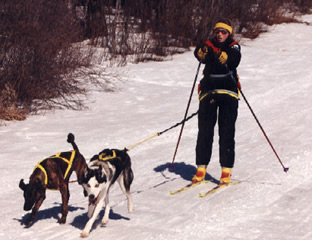 |
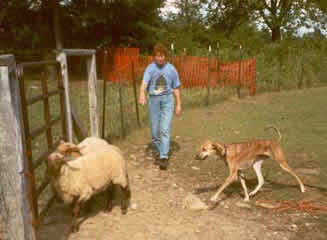 |
| Hannun Shi'Rayan skijoring with Alaskan Huski friend
Marley, owners Kathy Pickett & Dominique C. de Caprona,
photo Cynthia Curtis 1999 |
Shi'Rayan's Iswaar at Mazoe herding, owners Annie Chamberlain
& Dominique C. de Caprona |
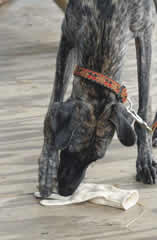 |
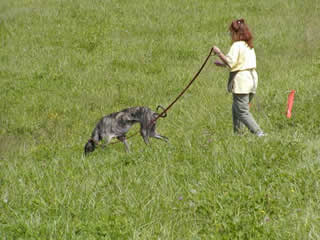 |
| Najeeb Strom Shi'Rayan "indicating" |
Strom tracking with owner Ellen Brady |
Sloughi in Competition (Agility)
 |
 |
 |
 |
| V'Ifricija Nuri al Baida, from top clockwise, balancing, going through tire, climbing wall and finally descending. Owner and photographer Eve Schwender, Germany |
|
 |
Azali Dau al Gamar, owner Marietta Heil, photo Oliver
Eberhardt |
Sloughi in Competition (Lure Coursing)
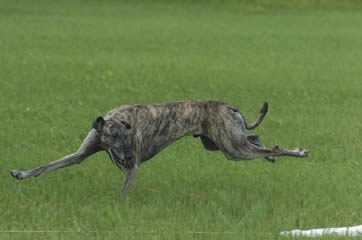 |
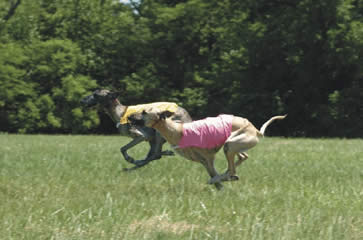 |
| Fahel Shi'Rayân running the lure.
Owner Dominique C. de Caprona, photographer Shot On Site |
Fahel and Mathal Shi'Rayân. Owner Dominique C. de Caprona, photographer Shot On Site |
Sloughi Champions
NATIONAL OVAL TRACK RACING ASSOCIATION
SUPREME OVAL RACING CHAMPIONS (SORC)
Amir Shi'Rayan (2000)
Ch. Bouthayna Shi'Rayan (2002)
Ch. Fahel Shi'Rayan (2003)
OVAL RACING CHAMPIONS (ORC)
Ch. Aswad Shi'Rayan (June 16, 1996)
Amir Shi'Rayan (September 15, 1996)
Ch. A'Ssissa Shi'Rayan (September 14, 1997)
Ch. Badir Shi'Rayan (May 16, 1999)
Ch. Bouthayna Shi'Rayan (September 26, 1999)
Ch. Fahel Shi'Rayan (October 22, 2000)
Ch. Bassel Shi'Rayan (October 22, 2000)
Ch. Balsam Shi'Rayan (October 29, 2000)
Ch. Batal Shi'Rayan (April 28, 2001)
Ch. Syringa Happiness at Shi'Rayan (October 20, 2001)
Ch. Chamisa Schuru-esch-Schams (October 27, 2001)
Ch. Hayifa Shi'Rayan (May 26, 2002)
Haadi Shi'Rayan (June 30, 2002)
Ch. Fa'Iq Shi'Rayan (April 12, 2003)
Ch. I'Saar Shi'Rayan (October 26, 2003)
SENIOR OVAL RACERS (SOR)
Amir Shi'Rayan
Ch. Aswad Shi'Rayan
Ch. A'Ssissa Shi'Rayan
Ch. Bouthayna Shi'Rayan
Ch. Balsam Shi'Rayan
Ch. Syringa Happiness at Shi'Rayan
NOTRA NATIONAL CHAMPIONS
1995 Amir Shi'Rayan & Ch. Aswad Shi'Rayan
1996 Ch. A'Ssissa Shi'Rayan
1997 Ch. A'Ssissa Shi'Rayan
1998 Ch. Aswad Shi'Rayan
1999 Ch. Badir Shi'Rayan
2000 Ch. Fahel Shi'Rayan
2001 Ch. Bouthayna Shi'Rayan & Ch. Syringa Happiness
at Shi'Rayan
2002 Haadi Shi'Rayan
2003 Ch. Fahel Shi'Rayân
LARGE GAZEHOUND RACING ASSOCIATION
SUPERIOR GAZEHOUND RACING CHAMPIONS 5(SGRC5)
Ch. Fahel Shi'Rayan (2003)
SUPERIOR GAZEHOUND RACING CHAMPION 4 (SGRC4)
Ch. Fahel Shi'Rayan (2002)
SUPERIOR GAZEHOUND RACING CHAMPION 3 (SGRC3)
Ch. Fahel Shi'Rayan (2002)
SUPERIOR GAZEHOUND RACING CHAMPION 2 (SGRC2)
Ch. Fahel Shi'Rayan (2001)
SUPERIOR GAZEHOUND RACING CHAMPIONS (SGRC)
Ch. Aswad Shi'Rayan (1999)
Ch. A'Ssissa Shi'Rayan (2000)
Ch. Fahel Shi'Rayan (2001)
Ch. I'Saar Shi'Rayan (2003)
Ch. Hayifa Shi'Rayân (2004)
GAZEHOUND RACING CHAMPIONS (GRC)
Ch. A'Ssissa Shi'Rayan (May 3, 1998)
Ch. Aswad Shi'Rayan ( May 16, 1998)
Ch. Fahel Shi'Rayan (October 16, 1998)
Ch. Badir Shi'Rayan (September 11, 1999)
Ch. Bassel Shi'Rayan (September 12, 1999)
Amir Shi'Rayan (April 29, 2000)
Ch. Balsam Shi'Rayan (September 9, 2000)
Ch. Bouthayna Shi'Rayan (September 23, 2000)
Ch. Syringa Happiness at Shi'Rayan (September 7, 2001)
Ch. Hayifa Shi'Rayan (September 8, 2001)
Ch. Fahad Shi'Rayan (November 10, 2001)
Haadi Shi'Rayan (December 8, 2001)
Ch. Dalal Shi'Rayan (December 30, 2001)
Ch. Batal Shi'Rayan (March 30, 2002)
Ch. Chamisa Schuru-esch-Schams (March 30, 2002)
Ch. Rym Cassandra (March 31, 2002)
Tarfa (June 9, 2002)
Ch. Fa'Iq Shi'Rayan (June 29, 2002)
Ch. I'Saar Shi'Rayan (June 29, 2002)
Ghamira Shi'Rayan (September 7, 2002)
Ch. Laza Shi'Rayan (October 20, 2002)
Munya Shi'Rayan (May 26, 2003)
Ch. Hannan Shi'Rayân ( May 23, 2004 |
| AMERICAN SIGHTHOUND FIELD ASSOCIATION
HIGHEST POINTED SLOUGHI IN ASFA AND
ONLY FOUNDATION COURSER OF MERIT IN ASFA
Ch Bouthayna Shi’Rayan
#1 MISCELLANEOUS OVER 18" (1996-2000)
(SLOUGHI, AZAWAKH, CHART POLSKI, GALGO ESPANOL, MAGYAR
AGAR)
1996 Ch. A’Ssissa Shi'Rayân
1997 Ch. Balsam Shi'Rayân
1998 Ch. Fahad Shi'Rayân
1999 Ch. Fahel Shi'Rayân
2000 Ch. Balsam Shi'Rayân
#1 SLOUGHI IN ASFA
2001 Ch.Rym Cassandra
2002 Ch.Rym Cassandra & Ch.Bouthayna Shi'Rayân
2003 Ch. Ibtsama Haifa Shi'Rayân
SFAA LURE COURSERS OF MERIT (SFAA LCM)
Ch. Bouthayna Shi'Rayân
Ch. Fahel Shi'Rayân
Ch. Balsam Shi'Rayân
SFAA FIELD CHAMPIONS
FOUNDATION COURSING CHAMPIONS IN ASFA
Ch. A'Ssissa Shi'Rayân
Ch. Bouthayna Shi'Rayân
Ch. Aswad Shi'Rayân
Ch. Balsam Shi'Rayân
Amir Shi'Rayân
Ch. Badir Shi'Rayân
Ch. Fahad Shi'Rayân
Ch. Fahel Shi'Rayân
Ch. Chamisa Schuru-esch-Schams
ASFA FIELD CHAMPIONS (AFTER APRIL 2001)
Rym Cassandra
Hayifa Shi'Rayân
|
|
























